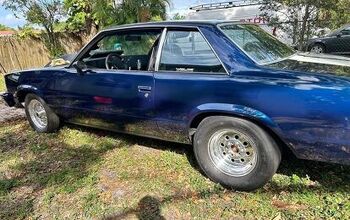IIHS to Automakers: Stop Tapping the Brakes on Rear-seat Safety

The Insurance Institute for Highway Safety, currently on a never-ending quest to improve automotive safety and provide underwriters with data, suggested on Thursday that rear-seat passengers are getting the short end of the stick. The announcement comes shortly after the State of Washington announced a new law that would update its Child Passenger Restraint Law, requiring older children to utilize a booster seat.
Having looked at rear-seat safety for years, the IIHS claims rear-seat occupants are now at a disadvantage compared to occupants in the front row. The group aims to develop a new evaluation method to encourage automakers to improve safety systems for back seat passengers and track their progress.
“Manufacturers have put a lot of work into improving protection for drivers and front-seat passengers. Our moderate overlap front crash test and, more recently, our driver-side and passenger-side small overlap front tests are a big reason why,” IIHS President David Harkey said. “We hope a new evaluation will spur similar progress in the back seat.”
Thanks to crash tensioners, airbags, and structural improvements designed to help automakers ace the IIHS small overlap tests, the safety of front-seat occupants has only grown over the past two decades. The same cannot be said for the people behind them, even though it was long assumed that the back seat was the safest place to be in the event of a crash.
While the group never directly refutes that assumption, it did say that more should be done to improve safety, adding that it’s actively hunting for supportive data. IIHS researchers used two national databases to find 117 crashes in which rear-seat occupants were killed or seriously injured. The most common type of injury, found in 22 of the injured occupants and 17 of the 37 fatalities with documented injuries, was to the chest.
From the IIHS:
In many of the cases in the new study, the back-seat passengers were injured more severely than the front-seat occupants, suggesting the restraints in the rear didn’t perform as well as the ones in the front.
Using information in the case records — including things like photographs, police and medical records, and crash investigation and autopsy reports — the researchers determined that the rear-seat chest injuries were mostly due to excessive forces from the shoulder belt.
Force limiters like the ones in the front seat would be one way to reduce belt injuries. Another possible solution is an inflatable seat belt of the type introduced by Ford and Mercedes-Benz. These belts inflate in a crash to better distribute forces across the torso and chest.
Head injuries were the second most-likely cause of death but, unlike the chest-related deaths, the IIHS claims most were unsurvivable. It was suggested that, under ideal circumstances, something could be done to minimize injuries to the chest while ensuring that the head doesn’t snap forward on its own.
“This is a big reason why force limiters usually go hand in hand with crash tensioners,” explained IIHS Senior Research Engineer Jessica Jermakian. “With a crash tensioner, a person is held firmly against the seat from the beginning of the crash, so a slight loosening of the belt from the force limiter isn’t a big a problem.”
There was also an emphasis placed on children, as they are more susceptible to injuries caused by ill-fitting seat belts and being tossed around the cabin in the event of a crash. However, the IIHS ultimately decided that child restraints have come up in the world and that it’s adults and teens who are taking on more risk in the backseat.
“Child restraints are so effective that when young children in properly used restraints die, it’s usually because the crash was so severe that improving the restraints wouldn’t have made a difference,” explained Jermakian. “The fact that our sample had mostly survivable crashes tells us that we need to do a better job restraining adults and older children in the back seat.”
The IIHS says it’s too early to begin telling automakers what, exactly, should be done. Right now the group is looking at everything from improving belt restraints to implementing rear-seat airbags. Its primary goal remains finding an effective way to evaluate rear-seat protection in a manner that “will prompt automakers to figure out what combination of technologies works best.”
[Image: IIHS]

A staunch consumer advocate tracking industry trends and regulation. Before joining TTAC, Matt spent a decade working for marketing and research firms based in NYC. Clients included several of the world’s largest automakers, global tire brands, and aftermarket part suppliers. Dissatisfied with the corporate world and resentful of having to wear suits everyday, he pivoted to writing about cars. Since then, that man has become an ardent supporter of the right-to-repair movement, been interviewed on the auto industry by national radio broadcasts, driven more rental cars than anyone ever should, participated in amateur rallying events, and received the requisite minimum training as sanctioned by the SCCA. Handy with a wrench, Matt grew up surrounded by Detroit auto workers and managed to get a pizza delivery job before he was legally eligible. He later found himself driving box trucks through Manhattan, guaranteeing future sympathy for actual truckers. He continues to conduct research pertaining to the automotive sector as an independent contractor and has since moved back to his native Michigan, closer to where the cars are born. A contrarian, Matt claims to prefer understeer — stating that front and all-wheel drive vehicles cater best to his driving style.
More by Matt Posky
Latest Car Reviews
Read moreLatest Product Reviews
Read moreRecent Comments
- Jkross22 Not to rub salt in the wound, but why would you put your hq in some extraordinarily expensive real estate like Manhattan Beach? I know little of Fisker the person, but this reeks of ego and the desire for appearances.
- 3-On-The-Tree I’ve responded to several bike accidents where if the guy wasn’t wearing a helmet he would’ve been in a casket. Plus it saves your hearing.
- Wjtinfwb Nice cars and a find if you're into Radwood type iron. But a near 40 year old anything, even something as robust as a Legend is going to have failure points that would be prohibitively expensive to fix. Electronics, A/C, leaky old gaskets, creaking suspension bushing etc., not to mention the lack of safety gear and an interior that no doubt has "seen a lot". I applaud the manual transmission, but you could likely find something 30 years newer for not much more money to hone your heel and toe skills on before graduating to a more expensive ride.
- ScarecrowRepair Considering how over-priced Apple products are, I doubt a cheap Rivian is in the works.
- Dick Mottram What happens when you are on slippery pavement and AEB slams on the brakes. I see it causing many accidents in the winter!

































Comments
Join the conversation
37 fatalities from searching two national databases? The IIHS needs to turn off the lights and go home. They've outlived their purpose.
This is why I don't let rear passengers sit in my car unbuckled. "I don't have to wear my seatbelt if I'm in the back, do I?" Uh, yes, you do.